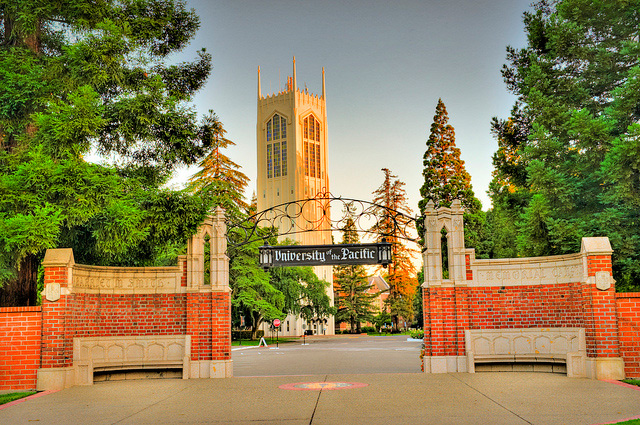
University of the Pacific - Credit: University of the Pacific
Stockton among areas leading the economic growth in Northern California
October 13, 2018 - The California economy should maintain strong growth through 2019, according to the latest projection from the Center for Business and Policy Research at the University of the Pacific.
The forecast projects a growth slowdown from 2020 to 2022 with an increasing risk of a mild recession. California's real gross state product is projected to grow at 3.2 percent in 2018 and 2019, and average 2 percent annual growth for 2020 to 2022.
California's record low unemployment rate of 4.2 percent is projected to fall further to a low of 3.9 percent in 2019 before gradually increasing. Nonfarm payrolls are projected to grow at a 1.9 percent rate in 2018 and gradually decline to below 1 percent growth by the end of 2020.
Most of the Northern California metro areas covered in the forecast are growing faster than the state as a whole with the San Jose, Stockton and Merced areas leading the way. The continued pace of Bay Area growth is remarkable in light of its housing and labor force constraints as unemployment is below 3 percent throughout the region. The Bay Area spillover effects are helping to boost Central Valley areas, especially Stockton where new fulfillment and distribution centers and a commuter-led boost in residential development are driving growth. Sacramento job growth has been slightly slower than other areas of Northern California, but we expect Sacramento's government-based economy to maintain job growth at 2 percent in 2020 as other areas slow down.
In addition to the detailed economic forecast for California and eight Northern California metropolitan areas, the report reviews the 11 propositions on California's November 2018 ballot, and most notably raises economic concerns with Prop. 3 (water bond), Prop. 6 (transportation tax repeal) and Prop. 10 (rent control). The full forecast can be downloaded from the Center's website at Pacific.edu/CBPR.
The Center for Business and Policy Research at the University of the Pacific was founded in 2004 and was known as the Business Forecasting Center until March 2015. The center is a joint effort of Pacific's Eberhardt School of Business and McGeorge School of Law programs in public policy and has offices at the Sacramento and Stockton campuses. The center produces economic forecasts of California and eight metropolitan areas in Northern and Central California, in depth studies of regional economic and policy issues, and conducts custom studies for public and private sector clients. For more information, visit Pacific.edu/CBPR.
Highlights of the October 2018 California Forecast
- Over the next 12 months, real gross state product is forecast to grow at a strong 3.1 percent pace before dropping to 2.3 percent growth in 2020 as recession risks grow.
- The California unemployment rate is forecast to average 4.2 percent for 2018 and fall further below its record low to 3.9 percent in 2019 before gradually increasing.
- Nonfarm payroll jobs will grow 1.6 percent over the next 12 months, dropping below 2 percent growth for the first time since 2011. Payroll growth will drop below 1 percent by late 2020 which is expected for an economy at full employment after a long expansion.
- Health Services has become the largest employment sector in the state after a period of rapid growth. Health services is projected to add more than 35,000 positions over the next 12 months, a slowdown from the 85,000 health services jobs added in 2017.
- Professional Scientific and Technical Services is a high-paying sector that has fueled the recovery and is forecast to be a growth leader in 2019 adding over 60,000 jobs.
- Growing tourism and a gradual shift in consumer spending from retail to restaurants has fueled rapid growth in Leisure and Hospitality sector. This sector has added up to 75,000 jobs in recent years, but we project about 10,000 new jobs in each of the next few years as rising labor costs and low labor availability drives change in the hospitality sector.
- State and local government employment experienced solid 2 percent employment growth from 2014 to 2017 as public budgets, especially in education, recovered. However, state and local government hiring will drop below 1 percent for the next several years in spite of revenue growth as these entities grapple with rising costs of pensions and other compensation.
- Construction jobs have been growing rapidly in recent years as the hard hit sector continues to recover. We expect a slight slowdown in construction job growth in 2019, about 20,000 new jobs compared to 40,000 to 50,000 in recent years. Job growth is limited by worker availability, and construction wages have been growing fast, and we expect job growth to pick up after 2019 as workers respond to higher wages.
- Single family housing starts are projected to surpass 65,000 this year and level off at around 75,000 in 2020 and beyond. Multi-family production is projected to be near 55,000 units this year and stabilize near this level. This projection of 130,000 new units per year will be enough to keep up with modest 0.7 percent projected annual population growth, but will not be enough to provide relief to California's housing crisis.
- California's population growth rate has declined to 0.7 percent and is projected to remain at this level through 2022. California's population will reach 40 million next year, and is adding about 275,000 new residents per year.
Source: Center for Business and Policy Research at the University of the Pacific









